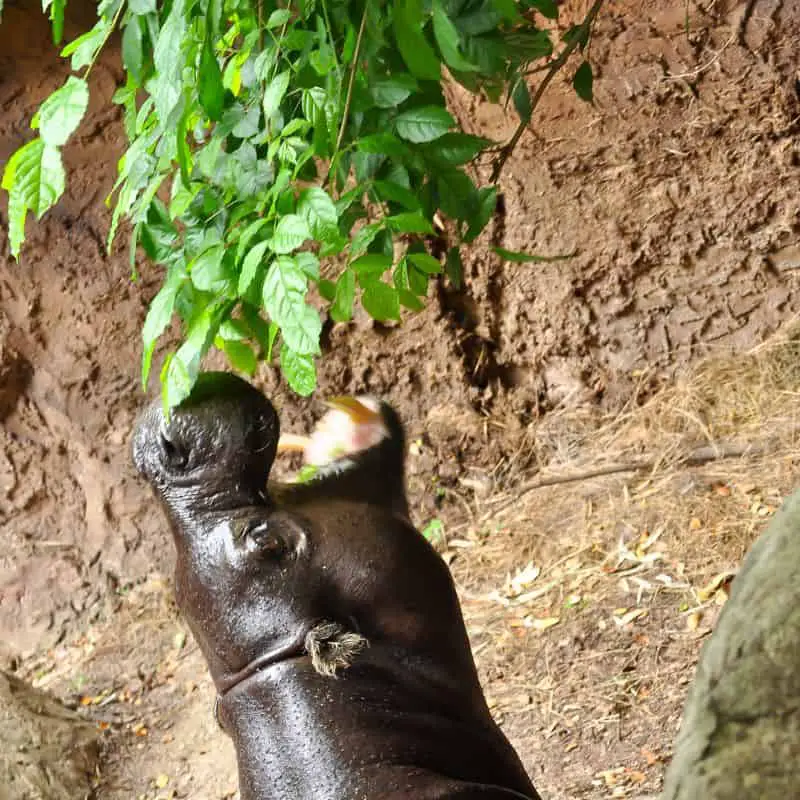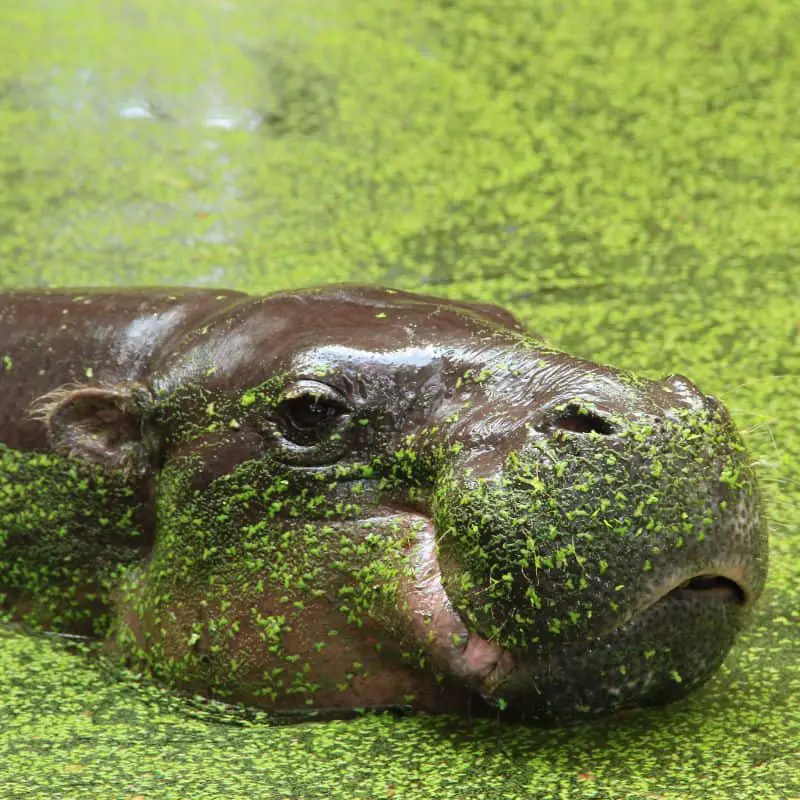If you were to describe a hippo, huge would probably be one of the first things that come to mind. But hippos come in more than one size; namely, there is a smaller variety known as the pygmy hippo.
The short, solitary, seldom vocal, non-swimmer, and nocturnal pygmy hippos are herbivores that live in Western Africa. They’re hairless and sound breeders with unique lungs and have a lifespan of 27 years in the wild. The endangered species differs from typical hippos in size, appearance, and behavior.
In this article, we’ll look at some interesting information about the lives of these tiny and adorable pygmy hippos.
Let’s get started.

- Top 12 Facts About The Pigmy Hippopotamus
- 1. Pygmy Hippos Are Native To Western Africa
- 2. They Have Short Bodies
- 3. They Are Hairless, Narrow Headed
- 4. Pygmy Hippos Are Solitary
- 5. They Are Primarily Nocturnal Animals
- 6. Pygmy Hippos Are Herbivores
- 7. Pygmy Hippos Have Lungs Well Adapted to Aquatic Life
- 8. Pygmy Hippos Do Not Swim
- 9. Life Span
- 10. They Breed Throughout the Year
- 11. Pygmy Hippos Are Usually Silent
- 12. Pygmy Hippos Are Endangered
- What Sets Pygmy Hippos Apart From Other Hippos?
- Final Thoughts On The Pygmy Hippo
- FAQs
Top 12 Facts About The Pigmy Hippopotamus
Here are twelve fun facts about these fascinating creatures:
1. Pygmy Hippos Are Native To Western Africa
The pygmy hippo, a miniature version of the common hippopotamus, lives in the forests and swamps of Western Africa.
Most are located in Liberia, with smaller groups in Sierra Leone, Guinea, and Ivory Coast.
The animals living in Sapo National Park in eastern Liberia are especially important to protect since it’s one of their few remaining natural homes.
2. They Have Short Bodies
Adult pygmy hippos weigh between 400 and 600 pounds, which is only a quarter of the size of their much larger cousins that can reach more than 7000 pounds.
They are only half as tall as common hippos, measuring 4.5 to 6 feet tall. They have an average height of 2.5 to 3 feet at the shoulders.
3. They Are Hairless, Narrow Headed
The Pygmy Hippopotamus is a more compact version of the Common Hippopotamus and has a rounded, narrow head with a longer neck and eyes set on the sides instead of the front.
They have less prominent nostrils and spend less time in the water than common hippos.
It has smooth and almost hairless skin that is greenish-black above, fading to gray on the sides and grayish-white below.
There are no sweat or scent glands; however, mucus glands produce a thick, oily red substance called blood sweat, which acts as an antibiotic and prevents dehydration by protecting against sun exposure.
It has well-separated toes with sharp nails, unlike the Common Hippopotamus, which has webbed feet.
The Pygmy Hippopotamus also has tusk-like incisors and canines that grow rapidly.
It has large, rounded ears and nostrils that can be closed when the animal is underwater, just like common hippos.

4. Pygmy Hippos Are Solitary
Pygmy Hippos are natural loners, and their nocturnal habits make them even more challenging to spot.
They’re also much less social than a regular hippopotamus, so you’ll usually find them alone or in pairs.
However, you might come across a small family group every once in a while – but that’s pretty rare.
Males have larger territories than females, which they mark with their droppings.
5. They Are Primarily Nocturnal Animals
Pygmy hippos are primarily, but not exclusively, nocturnal animals, spending most of their time in the water and moving around at night to eat.
Pygmy hippos are highly reclusive and timid creatures that prefer to remain hidden in swamps, ditches, or rivers during the day.
It’s unusual for them to surface unless they’re feeding.
In recent years, pygmy hippos have been radio-collared, and it was found that they are most active in the afternoon till midnight.
However, camera traps set up in Liberia and Sierra Leone showed that they are active all night as well as during the day.
6. Pygmy Hippos Are Herbivores
Pygmy hippos are herbivores, which you can tell by their compound stomachs. In the wild, they eat many plants like ferns, roots, grasses, and young tree stems. They’ve also been known to eat sweet potato leaves and shoots from rice plants.
Pygmy hippos primarily consume their food between mid-afternoon and midnight, spending around 5.8 to 6 hours a day. But recent findings from camera traps show that they can graze at any time of day or night.
They may strip off leaves by putting the twigs in their mouths and shaking their heads.
They can even stand upright on their hind legs while using their front legs to support themselves against tree trunks so they can stretch as high as possible.

7. Pygmy Hippos Have Lungs Well Adapted to Aquatic Life
The lungs of Pygmy hippos are designed to fill rapidly with fresh air when they emerge onto the surface of the water.
It’s an incredible ability that allows the pygmy to replenish oxygen more quickly (in two seconds) than other animals.
They can stay submerged for 3-4 minutes after one breath.
8. Pygmy Hippos Do Not Swim
Strangely, an animal that loves water can’t swim, but this is the truth for pygmy hippos.
Even though they are semi-aquatic, they cannot swim, just like common hippos.
Instead, pygmy hippos walk underwater and can easily sink and rise to the surface due to the high-fat content in their bodies, making them buoyant.
9. Life Span
The average lifespan of a pygmy hippo in the wild is 27 years, while those living in captivity or under managed care may live up to 42 years.
10. They Breed Throughout the Year
Pygmy hippos reach sexual maturity at 4-5 years old, with an estrus cycle of 35.5 days. The gestation period is 188 days, and a single baby pygmy hippo is born weighing 4.5-6.2 kg on average.
Twin births are rare, and unlike common hippopotamus babies, pygmy hippo births always occur on land rather than in water.
The breeding season for pygmy hippos lasts throughout the year, but more births occur during the early dry season (November-January).
Young animals are often left alone by their mothers, as they cannot follow them yet.
Mothers will return regularly to feed their young, protecting them from predators such as crocodiles and hyenas.
This behavior explains why young animals are rarely found with adults.
11. Pygmy Hippos Are Usually Silent
Pygmy hippos use a combination of noises and body language to communicate.
They can grunt and squeak but are usually silent.
Signs of submission in hippo culture include lying prone and urinating while slowly wagging the tail. If alarmed, the hippo may release its breath with a loud huff.
12. Pygmy Hippos Are Endangered
There are only 2000-2499 adult individuals left on the planet. IUCN classed pygmy hippos as endangered because of their highly fragmented and decreasing population trend.
The population of pygmy hippos is facing several threats which might lead to the extinction of this beautiful creature. These threatening factors are:
- Production of annual and biannual non-timber crops
- Mining
- Hunting and trapping
- Deforestation
- Wars, military exercises, and civil unrest
While it’s great that pygmy hippos breed well in captivity, we must do more to ensure they live happily in their natural habitat.
What Sets Pygmy Hippos Apart From Other Hippos?
Though pygmy hippos seemingly have many similarities with common hippos, they are, in reality, quite different from them.
Let’s dig deeper to have a better idea.
- Pygmy hippos have a significantly different appearance from normal hippos. They are smaller in size (1/4th the weight of common hippos) and height (about half that of typical hippos), weighing 400-600 pounds, compared to common hippos, which typically weigh up to 6000 pounds and even reach up to 7000 pounds.
- Pygmy hippos are considerably smaller than other hippos. Pygmy hippos have longer necks and smaller, rounder heads than their bigger counterparts proportionally. Compared to common hippos, the eyes of pygmy hippos are less prominent and positioned sideways.
- Pygmy hippos have smooth, almost hairless skin that is greenish-black above and grayish-white below, whereas common hippos are purple-gray or slate brown with a lower surface and surface around eyes to be brownish pink.
- Pygmy hippos have well-separated functional toes with sharp nails on each toe, whereas common hippos have webbed feet.
- While common hippos have an average lifespan of 40 years in the wild and 61 years in captivity, pygmy hippos only live around 27 years in the wild and 42 years in captivity.
- Common hippos are found throughout much of sub-Saharan Africa, in and around rivers across the savanna. They also live in Angola. Pygmy hippos, however, only inhabit Western Africa, mainly in Liberia.

Final Thoughts On The Pygmy Hippo
Pygmy hippos are a fascinating natural occurrence and share many similarities to common hippos. However, their size, appearance, and numbers differ quite a bit.
They have become endangered due to human activity and need our help to improve their vanishing lives.
FAQs
How Long Can Pygmy Hippos Live?
Pygmy hippos have a mean life expectancy of 27 years in the wild and 42 years in captivity.
What Do Pygmy Hippos Eat?
Pygmy hippos are plant-eaters; that’s why they have a four-chambered stomach. In the wild, they consume plants like ferns, grasses, roots, and young tree bark; they have been also known to feast on sweet potato leaves and shoots from rice crops.
Can Hippos Be Friendly?
Despite their cute appearance, hippos can be deadly if they feel threatened. They have fast-growing teeth reaching up to 20 inches long(canines), and they use them primarily for self-defense or fighting with other hippos. Male hippos are more commonly known for their aggressive behavior and fights.
